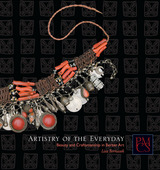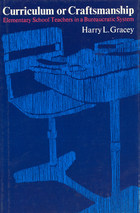3 books about Craftsmanship

Artistry of the Everyday
Beauty and Craftsmanship in Berber Art
Lisa Bernasek
Harvard University Press, 2008
Imazighen! Beauty and Artisanship in Berber Life presents the Peabody Museum's collection of arts from the Berber-speaking regions of North Africa. The book gives an overview of Berber history and culture, focusing on the rich aesthetic traditions of Amazigh (Berber) craftsmen and women. From ancient times to the present day, working with limited materials but an extensive vocabulary of symbols and motifs, Imazighen (Berbers) across North Africa have created objects that are both beautiful and practical. Intricately woven textiles, incised metal locks and keys, painted pottery and richly embroidered leather bags are just a few examples of objects from the Peabody Museum's collections that are highlighted in the color plates. The book also tells the stories of the collectors--both world-traveling Bostonians and Harvard-trained anthropologists--who brought these objects from Morocco or Algeria to their present home in Cambridge in the early twentieth century. The generosity of these donors has resulted in a collection of Berber arts, especially from the Tuareg regions of southern Algeria, that rivals that of major European and North African museums.
[more]

Craftsmanship and the Michigan Union Carpenter
Philip A. Korth
University of Wisconsin Press, 1991
This volume celebrates the craftsmanship of Michigan Union carpenters. Retired members of the United Brotherhood of Carpenters share pride in their skill and accomplishments, through edited oral histories in this volume. Their histories convey a sense of self, a sense of dignity, and an appreciation of the significance of their work.
[more]

Curriculum or Craftsmanship
Elementary School Teachers in a Bureaucratic System
Harry L. Gracey
University of Chicago Press, 1972
Sociologist Harry L. Gracey spent two years studying an East-Coast school system, which he calls "Brookview," and determined that the bureaucratic social structure of schools can have a profound and irreversibly negative effect on the creativity of teachers. This volume tells the story of the "Wilbur Wright" elementary school in Brookview. It examines the relationship between the educational institution as a bureaucracy and the goals of the two main types of teaching orientation found in elementary schools such as Wright.
The majority of teachers are "production" oriented. They believe that their job is to see that the children in their charge complete as much of the standardized grade level curriculum as possible during the school year. They do achieve some success in preparing children for life in a society where bureaucracy is the dominant form of social organization.
The other significant type of teaching orientation is that of the "craftsmen." These instructors see their goal as the development of each individual's learning potential, with the curriculum built upon the specific needs and interests of each child. Bureaucratic school structures do nothing to promote this kind of teaching.
Any ideas that are at variance with the school's organizational structure will fail. The craftsman teachers do not have the time to communicate the standardized programs desired by the school board and also to make use of their own individualistic techniques. Further, the continued use of the former cancels the effects of the craftsman approach.
In delineating his conclusions, Professor Gracey includes his observations on the community and educational setting of the study, the two types of teachers, the administration, the parents, and the children's response to educational organization.
This study is unique in approaching its educational subject matter from a sociological point of view; Professor Gracey intended it as a study of behavior in organizations. It should also serve educational goals, however, and will therefore interest educators and concerned citizens as well as sociologists.
The majority of teachers are "production" oriented. They believe that their job is to see that the children in their charge complete as much of the standardized grade level curriculum as possible during the school year. They do achieve some success in preparing children for life in a society where bureaucracy is the dominant form of social organization.
The other significant type of teaching orientation is that of the "craftsmen." These instructors see their goal as the development of each individual's learning potential, with the curriculum built upon the specific needs and interests of each child. Bureaucratic school structures do nothing to promote this kind of teaching.
Any ideas that are at variance with the school's organizational structure will fail. The craftsman teachers do not have the time to communicate the standardized programs desired by the school board and also to make use of their own individualistic techniques. Further, the continued use of the former cancels the effects of the craftsman approach.
In delineating his conclusions, Professor Gracey includes his observations on the community and educational setting of the study, the two types of teachers, the administration, the parents, and the children's response to educational organization.
This study is unique in approaching its educational subject matter from a sociological point of view; Professor Gracey intended it as a study of behavior in organizations. It should also serve educational goals, however, and will therefore interest educators and concerned citizens as well as sociologists.
[more]
READERS
Browse our collection.
PUBLISHERS
See BiblioVault's publisher services.
STUDENT SERVICES
Files for college accessibility offices.
UChicago Accessibility Resources
home | accessibility | search | about | contact us
BiblioVault ® 2001 - 2025
The University of Chicago Press









